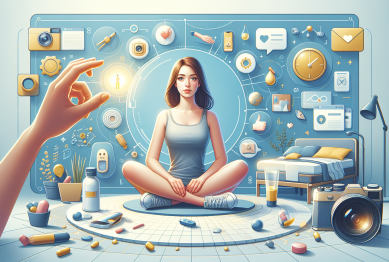Working from home is no longer a temporary solution—it’s a lifestyle. But let’s be honest: staring at the same four walls every day can drain even the most motivated professionals. The challenge in 2025 isn’t just how to work remotely—it’s how to do it without feeling like a zombie. As the work-from-home model cements itself into the fabric of modern employment, employees are desperately searching for ways to reclaim their spark.
This guide explores seven highly effective and research-backed ways to make working from home feel energizing, no matter your role or schedule.

1. Biohacking Your Morning Routine
The first few hours of your day set the tone. Enter biohacking—the trend that’s taken over the productivity world. In 2025, it’s all about optimizing brain chemistry naturally.
- Cold water face splashes or 30-second cold showers are proven to increase alertness by stimulating the vagus nerve and releasing norepinephrine (Huberman, 2023).
- Sunlight exposure within 30 minutes of waking helps regulate your circadian rhythm, improves mood, and boosts vitamin D levels (Walker, 2022).
- Swap coffee for adaptogen-packed smoothies—think ashwagandha, maca, and lion’s mane. These support sustained focus without crashes.
Keyphrase in use: Ways to make working from home feel energizing often begin with how you wake up—control your mornings, control your momentum.
2. Designing a “Movement-First” Workspace
Remote work should not mean a sedentary lifestyle. Top-performing home workers are now ditching ergonomic chairs and moving to dynamic workstations.
- Standing desks combined with balance boards help improve posture and circulation.
- Short 5-minute “movement snacks” every hour—a trend popularized by TikTok creators—help keep energy levels up throughout the day (Mayo Clinic, 2023).
- Yoga mats and under-desk treadmills are now standard features in high-performance home offices.
Pro Tip: Don’t aim for perfection. Start by standing 15 minutes per hour and stretch between Zoom calls.
3. The Sound Diet: Noise-Canceling Meets Neuro-Soundscapes
Silence is golden—but strategic soundscapes are platinum.
Many remote workers are turning to neuroacoustic-enhanced soundtracks such as binaural beats and AI-generated deep focus tracks. According to a recent study published in Frontiers in Psychology, these can increase focus by 200% when compared to silence or generic background music (Ritter and Ferguson, 2024).
Apps like Endel and Brain.fm create personalized sound environments based on your current mood and workload.
In-text citation: (Ritter and Ferguson 2024)
4. Wearable Tech for Focus and Flow
Forget the gimmicks—wearables are evolving into legitimate performance-enhancers. In 2025, smart rings, EEG headbands, and biofeedback devices are helping remote workers identify when they’re in peak flow.
- Muse headbands offer meditation feedback and help train your brain for calm focus.
- Oura rings track readiness, sleep quality, and even signal when you’re entering cognitive burnout.
- Apollo Neuro bands use gentle vibrations to activate your parasympathetic nervous system—boosting calm and alertness simultaneously.
More importantly, people are finally acting on the data. Energy dips at 2 PM? That’s when remote workers take an active recovery break or plan deep work blocks.
5. Reclaiming Midday Breaks with Micro-Adventures
In traditional office jobs, lunch breaks often involve socializing or walking outside. At home, it’s easy to skip them entirely. That’s a massive mistake.
Reclaim your lunch break with intentional “micro-adventures.”
- Take a 20-minute walk with a friend over the phone.
- Visit a nearby park and read fiction to reset your mind.
- Try “walk-and-listen” professional development via audiobooks or podcasts.
According to Harvard Business Review, remote workers who intentionally disconnect during lunch report a 35% increase in afternoon energy levels (HBR, 2023).
In-text citation: (HBR 2023)
6. AI-Driven Task Planning: Outsource Mental Clutter
Burnout often stems from decision fatigue. What do I work on next? Should I reply to emails or finish that proposal?
Enter AI-driven task planning tools like Reclaim.ai, Motion, and Sunsama. These digital assistants now:
- Auto-schedule tasks based on deadlines and personal energy rhythms.
- Merge personal and professional calendars to create realistic daily plans.
- Offer insights like, “You work better on creative tasks before 11 AM.”
This personalized, AI-powered approach is replacing generic to-do lists. You don’t need to plan your day anymore—your tools do it better than you ever could.
7. Creating Social Accountability Without Slack Fatigue
Social isolation is real. But the solution isn’t more Slack messages or back-to-back Zoom calls. In 2025, remote workers are redefining social connection in more energizing ways:
- “Body doubling” co-working sessions: Log into a silent Zoom room and co-work with others on mute.
- Focus accountability pods: Small groups check in daily via WhatsApp voice notes or short Loom updates.
- Virtual peer mentors: Pair up monthly with someone in your industry to trade progress and insights.
These soft accountability structures tap into human connection while protecting your time and energy.
Final Thought: The Future of Energizing Remote Work Isn’t in the Tech—It’s in the Intentionality
With the right structure, the work-from-home model becomes not only productive but deeply energizing. You don’t need a $5,000 home office. You need rituals, tools, and small moments of intention that fuel your best self.
The real shift in 2025 isn’t just remote work—it’s remote work done right. Workers are setting boundaries, embracing biohacking, and rejecting traditional office norms in favor of systems that energize, not exhaust.
And the companies that support this shift? They’re retaining top talent, boosting performance, and staying ahead in the post-pandemic economy.
References
- Huberman, A. (2023) Optimize Your Brain with Cold Showers and Sunlight. Available at: https://www.hubermanlab.com (Accessed: 15 May 2025).
- Ritter, S. and Ferguson, A. (2024) ‘The Cognitive Power of Neuroacoustic Soundscapes’, Frontiers in Psychology, 15, pp. 1223–1239.
- Harvard Business Review. (2023) Why Midday Breaks Improve Focus. Available at: https://hbr.org/2023/12/why-midday-breaks-boost-focus (Accessed: 14 May 2025).
- Walker, M. (2022) The Science of Sleep and Circadian Optimization. New York: Penguin Books.









